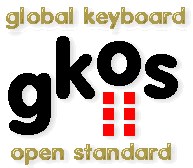Chording = pressing several keys at the same time => more characters with less keys.

GKOS Chording

What has given chording a bad name when it comes to typing?
The traditional chording keyboards are designed for one hand as the basic idea was that one hand takes care of typing while the other is free for operating the mouse. One-hand chording inevitably leads to difficult combinations of simultaneous key presses. Typically, there are more than 50 chords (combinations). The four fingers of one hand have one dedicated key each and, in addition, there are three keys for the thumb to manage. The combinations of these 7 keys are fairly difficult to learn and remember as well as hard to press physically unless you are a pianist. Consequently, chording keyboards, though having been around for a long time, never have become popular.
How to get rid of the difficulties of chording:
The GKOS keyboard has been designed with mobile telecommunications in mind. It splits the 6-key pad (3+3) and the mouse functions between two hands. Now, the chords become just few and even the mouse is more stable as the pointer is controlled by one hand and clicking is done by the other. Only 4 simple chords remain per hand in total. For letters and numbers, 3 chords is enough and, in fact, include the same number of simultaneous key presses (1...3) as what you already use with the PC QWERTY (e.g. A, SHIFT+A, Ctrl+Alt+Del). Physically, this is even easier with GKOS as you do not have to move your fingers to other positions on the keyboard. The letters are in alphabetical order and in groups of 3 which is a familiar concept to people who have been sending SMS with a GSM phone.
One more unique feature: The mapping of letters and most other characters makes it possible to have a compact virtual GKOS keyboard on the screen that can be used alternatively by a stylus/pen or on the GKOS keys on the back.
Seppo Tiainen 25 October 2002